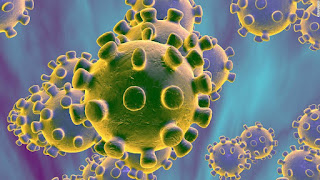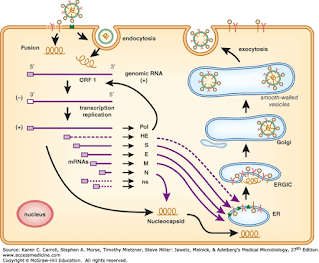Today we are going to talk about a virus, which is spreading very fastly all over the world. The virus which we are going to talk about is the CORONA VIRUS. So today we will talk about everything about this virus. So let’s start…

OVERVIEW OF CORONAVIRUS
According to the biological study, Coronavirus is a cluster of viruses that causes diseases in birds and mammals. Therefore humans are also mammals then in human beings these viruses cause respiratory infections, and one of the respiratory infections is a mild common cold.
Coronavirus can lead to diarrhea in cows and pigs but in chickens, they can cause upper respiratory infections. Various countries have been developed vaccines or antiviral drugs for the treatment of diseases caused by Coronavirus. Eg. Covishield, covaxin, Sputnik V etc.
BIOLOGICAL INTRODUCTION OF coV
The family of Coronavirus is coronaviridae, and it’s subfamily is Orthocoronavirinae and order is Nidovirales, Coronavirus is a member of Orthocoronavirinae subfamily.
All Coronavirus is coated with a positive sense single strained RNA genome and nucleocapsid of helical symmetry. Coronavirus has a genomic size of approximately 26 to 32 kilobases, but RNA viruses have the largest genomic size.
If we talk about its nomenclature then, Coronavirus is derived from the Latin word corona, which means crown or halo. Which is attributed to the royal appearance of these viruses or virus particles (virions).
INFECTION MECHANISM OF CORONAVIRUS

Now let’s talk about the infection mechanism of Coronavirus, the cell of the Coronavirus is uncoated and its RNA genome is deposited into the cytoplasm. The RNA genome of Coronavirus has 5 methylated caps and 3 polyadenylated tails which helps the RNA to attach to the ribosome for translation purposes.
This virus has also a protein which is known as replicas, which is encoded into its genome and helps RNA viral genome to transcribed into a new RNA copy by using the host cell machinery. When once the translation process of gene encoding completed, then the translation is stopped by a stop codon.
These are known as nested transcripts. Encoding of only one gene by mRNA transcript is called monocistronic. The protein of Coronavirus has not a definite shape, due to this, this replicase protein provides an extra fidelity to replication because it offers a proofreading function. After replication of the RNA genome, a long chain of polyprotein is formed, where all protein is attached.
Protease, a non-structural protein has the ability to separate the protein in the chain, this form is called the genetic economy of the virus, which helps the virus to encode the greatest number of genes in a single nucleotide.
DISCOVERY OF CORONAVIRUS

Biologists discovered the Coronavirus in the 1960s. But one of the earliest discovered Coronavirus is infectious bronchitis viruses in chickens and two viruses are discovered from the nasal cavities of human patients, which were suffering from the common cold, and subsequently, these two viruses are named human Coronavirus 229E and human Coronavirus OC43.
And in coming years different Coronavirus is discovered which lies in the same family as of two above human Coronavirus.
The newly discovered Coronavirus is SARS – CoV in 2003, HcoV – NL63 in 2004, HKU1 in 2005, MERS – CoV in 2012, and 2019 – nCoV in 2019. These later discovered viruses are found to be involved in critical respiratory tract infections.
ANCIENT HISTORY OF CORONAVIRUS
According to the biological study, the most recent common ancestor (MRCA) of Coronavirus has been found approximately around 8100 BCE.
Coronavirus has different categories that are, alphacoronaviruse, betacoronavirus, gammacoronaviruse and deltacoronavirus and their MRCA has been found about 2400 BCE, 3300 BCE, 2800 BCE, and 3000 BCE
respectively.
In the study, it is found that bats, birds, and other warm-blooded flying vertebrates are ideal hosts of the Coronavirus gene. Bats are an ideal host for alphacoronaviruse and beta coronaviruses, and birds are ideal hosts for gammacoronaviruse and delta coronavirus. This host helps Coronavirus to evolute in an advanced one.
Bovine Coronavirus and canine respiratory Coronavirus diverged from a common ancestor in 1951. Bovine and human Coronavirus OC43 diverged in 1899, if we talk about the Bovine Coronavirus then it has diverged from an equine Coronavirus species at the end of the 18th century.
Some biological researchers believed that human Coronavirus OC43 diverged from Bovine Coronavirus in 1890. And the MRCA of human Coronavirus OC43 has been labeled to the 1950s.
Biologists believed that Coronavirus evolved with bats and ancestor of SARS viruses for a long time and first infected the species of the gene Hipposideridae and subsequently spread to the species of Rhinolofidae and then to the civets and from civets, it spread ultimately to the humans, in the form of human Coronavirus.
Now let’s talk about the human Coronavirus.
CORONAVIRUS IN HUMAN : THE HUMAN CORONAVIRUS
In human beings, the major impact of Coronavirus is on the respiratory system. In human beings, it can cause common cold to all age categories of people. It can give respiratory infections to children as well as adults.
There are seven strains of human Coronavirus, which is –
1). Human Coronavirus 229E (HCoV – 229E)
2). Human Coronavirus OC43 ( HCoV – OC43)
3). SARS CoV
4). Human Coronavirus NL63 ( HCoV – NL63)
5). Human Coronavirus HKU1
6). Middle East respiratory syndrome Coronavirus. ( MERS – CoV)
7). Novel Coronavirus ( 2019 – nCoV)
Novel Coronavirus is also known as Wuhan pneumonia or Wuhan Coronavirus. (Novel means newly discovered).
The major symptoms of Coronavirus infections in human beings are given ahead. If you see any of these symptoms then you should immediately consult a doctor. Never ignore these symptoms.
MAJOR SYMPTOMS OF HUMAN CORONAVIRUS
* It leads to fever.
* Swollen adenoids of the throat.
* It can cause pneumonia ( direct viral pneumonia or secondary bacterial pneumonia)
* It can cause bronchitis ( direct viral bronchitis or secondary bacterial bronchitis)
* Shortness of breath
* Sore throat
* Coughing
* Running nose
*Difficulty in breathing
* Headache
* Feeling of unwell
HOW ITS SPREAD
Human Coronavirus can be spread through the contagious and non-contagious mode of transmission, it can include-
1). By air during coughing and sneezing.
2). By personal contact: touching or shaking hands.
3). Touching the virus-contaminated objects.
4). It can rarely be transmitted through fecal matter.
5). Eating not properly cooked meat of birds or pigs and goats.
HOW IT CAN BE PREVENT
Currently, there is no vaccine or antiviral drugs for the treatment of patients who are suffering from diseases caused by the Coronavirus. Maybe in the future, proper treatment would be introduced regarding this Coronavirus.
So till now, prevention is the best cure. Here some important prevention methods are given, which you can follow to reduce the infections.
- Wash your hands properly with disinfectant soap before and after doing some work.
- Avoid touching any person who is suffering from any kind of disease, especially the nose, mouth, eyes, and hands.
- Stop eating food with someone else. Eat food individually.
- Keep yourself hydrated, stay at home.
- If you feeling unwell then immediately consult with your doctor.
- Never ignore any symptoms.
Was this article helpful?
YesNo


